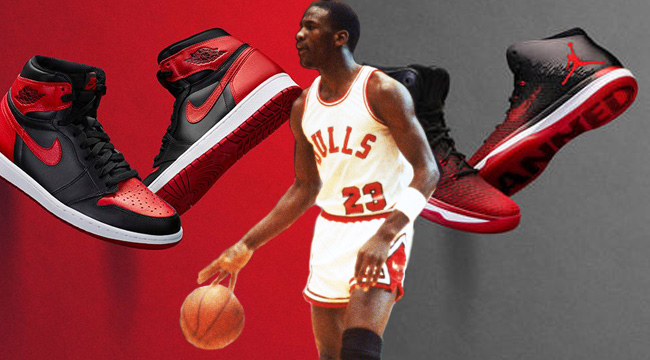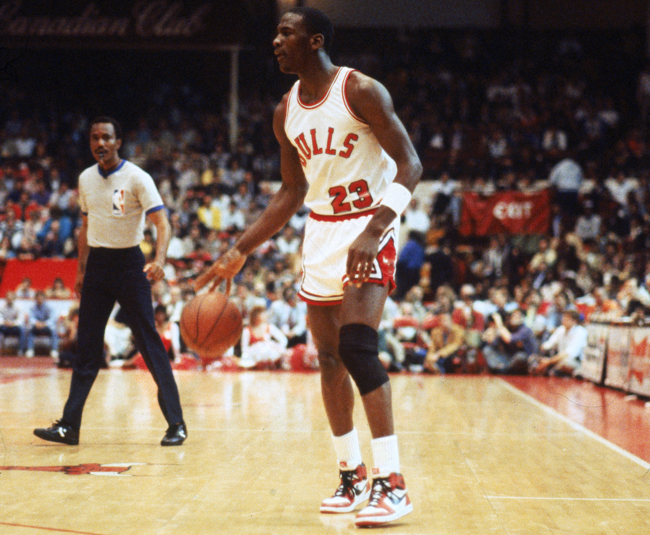
Perhaps the coolest part of Nike’s initial pitch meeting with a skeptical Michael Jordan was his reaction when he first saw their proposed black and red sneaker.
“I can’t wear that shoe,” Jordan said. “Those are the Devil’s colors.”
As retold in David Halberstam’s Playing for Keeps, Nike execs gently explained to their future standard-bearer that he now played for the Bulls, and that Carolina Blue was a thing of the past. With Jordan conceding that point, they were able to win him over with a visionary approach to marketing a star player, and the rest is sneaker history.
As demonstrated by the buzz for this Saturday’s retro of the “Banned” Air Jordan 1 — released concurrently with a matching AJ XXX1, an homage to its ancestor — the reverberations of that groundbreaking first sneaker are still being felt today. But the amazing thing about the Jordan Brand’s continued relevance after three decades is just how much had to go right before it even got off the ground.
What if Jordan had been hell-bent on sticking with Converse, a staple for NBA superstars which he’d worn to great effect at UNC? What if adidas, which he favored in practice, had realized what he brought to the table? And perhaps most importantly, what if his parents hadn’t practically dragged a reluctant M.J. onto a plane to Portland to hear the Swoosh’s pitch?
Once all those hurdles were cleared, the Jordan Brand ignited when its namesake blossomed into an exceptional player and an unparalleled competitor. But the final lightning strike came when the NBA quarantined a rookie Jordan’s black/red sneakers, the AJ1 lookalike Air Ship.
The reason the league got involved was relatively benign; the Ships broke an archaic rule forcing teammates’ sneakers to have matching color schemes. But Nike spun that into gold, claiming in a watershed commercial that it was the Air Jordan 1 that had been banned. Their initial goal was to sell $3 million in sneakers after three years; they instead cleared more than $130 million in the first year.
Though the AJ1 was a success at the cash register, that didn’t mean Jordan thought it was a wonder to behold. Nike probably had to cringe a bit when he offered a blunt assessment in his famous interview with David Letterman: “I agree with you. The shoes are ugly.” But the multi-colored shoes were totally different from anything else out there, and that was kind of the point.
“First and foremost, the shoes had to perform the way I wanted them to perform,” Jordan said in Drive from Within. “How they looked was a whole different issue, because you have to think about marketing strategy. You want people to pay attention. If you see somebody walking down the street in pink shoes, you are going to look at them.
“That’s exactly what happened with the first shoe.”
Just as Jordan evolved as a player over time, his first sneaker took on a different identity as the years passed. After the initial craze, the sneaker fizzled by the time it retroed in 1994, routinely spotted for $20 on discount racks. (Hindsight is 20/20, but one could have bought out a mall and conceivably put a down payment on a house with the profits a few decades later.)
“In 1994, the Jordan 1 didn’t sell at all,” said Snake America editor and AJ1 aficionado Sam Reiss. “The IV came back in ’99, so by the time the 1 was back out two years later, they sold a little more briskly. But I remember the Royals were on clearance racks in Montreal in 2002. They really only took off when Dunks became very popular around ‘03.”
Why the downturn in popularity in the 90’s? It was probably too early for people to be nostalgic for them, and after seven Tinker Hatfield classics, maybe sneaker buyers were turned off by the relative lack of bells and whistles.
Whatever the reason, the sneaker always had fans: Jordan collectors still snapped them up, pro skateboarders like the Bones Brigade loved the rugged rubber midsole, Dave Mustaine of Megadeth was a devotee, and denizens of the hardcore scene wore them on album covers and in mosh pits. This album by Youth of Today was probably the best example; they wore KO’s on the classic cover.
“A lot of hardcore kids wore Jordan 1’s since it was featured prominently on record covers, and hardcore kids are good at tracking down obscure items,” Reiss said. “The YOT album was in the ‘80’s, but the album was pretty big. My friend said YOT got their Jordans in like 1986 for $20.
https://i.giphy.com/12HHRMSRDTXTOg.gif
“Having sold my Jordan 1’s, I miss having them a bit, but I wasn’t wearing mine much anymore and I didn’t own a mattress at the time, so I had to do it. It would be nice to have a pair or two kicking around, but to me, being into sneakers was to have stuff nobody else wore.”
The Air Jordan 1 has experienced a significant renaissance in recent years, with OG colorways typically among the most anticipated sneaker releases. Perhaps it’s a coincidence that Kanye West and Jay Z made the black/red colorway a go-to around that time, but it sure doesn’t seem like it.
Regardless, the Jordan 1 has been part of countless people’s personal journeys over the years, proof that a truly great idea – combined with a little serendipity – can go a longer way than anyone could imagine. Trends come and go like tides on the beach and no brand is immune, but I’d still like to believe that 30 more years down the line, the AJ1 will still be what it is now: ubiquitous and timeless.
“Some stuff, like Jordan 1’s, is simply undeniable,” Reiss said. “It just makes sense they’re still popular. They’re such an awesome shoe. How could you not love them?”
The Air Jordan 1 Retro High OG “Banned” goes on sale at 10 a.m. ET on September 3, along with the recently unveiled Air Jordan XXX1.







